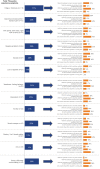The Patient Perspectives on Future Therapeutic Options in NASH and Patient Needs
- PMID: 31106203
- PMCID: PMC6457207
- DOI: 10.3389/fmed.2019.00061
The Patient Perspectives on Future Therapeutic Options in NASH and Patient Needs
Abstract
Background: Non-alcoholic steatohepatitis (NASH) is a chronic liver disease with severe complications and without approved therapies. Currently, there is limited data on the overall burden of the disease for patients or on patient needs and preferences. This study investigates patient preferences in relation to potential future therapies for NASH. In addition, the factors that are relevant to patients and their importance in relation to future treatment options are explored. Method: Telephone in-depth interviews (TDIs) preceded an online 30-min quantitative survey. The online survey included (1) multiple choice questions (MCQs) on NASH diagnosis and disease background. (2) An exercise to determine patients' satisfaction levels with information provided at diagnosis, and to explore symptomatology in detail. (3) Exercises to evaluate potential new products and product attributes, including a "drag and drop" ranking exercise, and an adaptive choice-based conjoint exercise (ACBC). (4) The EQ-5D-5L questionnaire and the Visual Analog Scale (VAS), which measures patients' health status. (5) Collection of socio-demographic data, and (6) Questions to measure patient satisfaction with the survey. Results: There were 166 patients included in this study from Canada [n = 36], Germany [n = 50], the UK [n = 30], and USA [n = 50]. Fifty seven percent of patients [n = 94] had had a liver biopsy for confirmation of NASH. Patients were often unable to link their symptoms to NASH or other conditions. ACBC results showed that efficacy, defined as "impact on liver status" was the single most important attribute of a potential future NASH therapy. Other attributes considered to have secondary importance included impact on weight, symptom control and the presence of side effects. The EQ-5D utility score was 0.81 and VAS = 67.2. Conclusion: "Impact on liver status" is the primary outcome sought. Patients demonstrate a general lack of understanding of their disease and appeared to be unfamiliar with longer-term consequences of NASH. It is necessary to improve patient understanding of NASH and its progressive nature, and there is a need for improving confirmatory diagnosis and monitoring.
Keywords: EQ5D-5L; adaptive choice-based conjoint; liver disease; non-alcoholic fatty liver disease (NAFLD); non-alcoholic steatohepatitis (NASH); patient preference; patient-based evidence; patient-reported outcomes.
Figures








Similar articles
-
Assessing physician preferences on future therapeutic options and diagnostic practices in non-alcoholic steatohepatitis.JHEP Rep. 2020 Feb 1;2(2):100081. doi: 10.1016/j.jhepr.2020.100081. eCollection 2020 Apr. JHEP Rep. 2020. PMID: 32190823 Free PMC article.
-
Cost of non-alcoholic steatohepatitis in Europe and the USA: The GAIN study.JHEP Rep. 2020 Jul 15;2(5):100142. doi: 10.1016/j.jhepr.2020.100142. eCollection 2020 Oct. JHEP Rep. 2020. PMID: 32775976 Free PMC article.
-
Cross-walk of the Chronic Liver Disease Questionnaire for Nonalcoholic Steatohepatitis (CLDQ-NASH) and the EuroQol EQ-5D-5L in patients with NASH.Health Qual Life Outcomes. 2023 Oct 14;21(1):113. doi: 10.1186/s12955-023-02195-x. Health Qual Life Outcomes. 2023. PMID: 37838660 Free PMC article.
-
Patient-reported outcomes in patients with non-alcoholic fatty liver disease: A narrative review of Chronic Liver Disease Questionnaire-non-alcoholic fatty liver disease/non-alcoholic steatohepatitis.J Gastroenterol Hepatol. 2021 Mar;36(3):629-636. doi: 10.1111/jgh.15172. Epub 2020 Jul 16. J Gastroenterol Hepatol. 2021. PMID: 32627871 Review.
-
Efficacy of SGLT2 Inhibitors Versus Pioglitazone in the Treatment of Non-alcoholic Fatty Liver Disease or Non-alcoholic Steatohepatitis: A Systematic Review.Cureus. 2023 Sep 22;15(9):e45789. doi: 10.7759/cureus.45789. eCollection 2023 Sep. Cureus. 2023. PMID: 37745748 Free PMC article. Review.
Cited by
-
Assessing physician preferences on future therapeutic options and diagnostic practices in non-alcoholic steatohepatitis.JHEP Rep. 2020 Feb 1;2(2):100081. doi: 10.1016/j.jhepr.2020.100081. eCollection 2020 Apr. JHEP Rep. 2020. PMID: 32190823 Free PMC article.
-
A clinical decision support tool for metabolic dysfunction-associated steatohepatitis in real-world clinical settings: a mixed-method implementation research study protocol.J Comp Eff Res. 2024 Oct;13(10):e240085. doi: 10.57264/cer-2024-0085. Epub 2024 Sep 20. J Comp Eff Res. 2024. PMID: 39301878 Free PMC article.
-
Adipokines and Endotoxemia Correlate with Hepatic Steatosis in Non-Alcoholic Fatty Liver Disease (NAFLD).Nutrients. 2020 Mar 5;12(3):699. doi: 10.3390/nu12030699. Nutrients. 2020. PMID: 32151020 Free PMC article.
-
Psychological Biomarkers and Fibrosis: An Innovative Approach to Non-alcoholic Fatty Liver Disease.Front Med (Lausanne). 2020 Oct 22;7:585425. doi: 10.3389/fmed.2020.585425. eCollection 2020. Front Med (Lausanne). 2020. PMID: 33195340 Free PMC article.
-
Lifestyle interventions for patients with non-alcoholic steato-hepatitis-Design, rationale and protocol of the study "target group-specific optimisation of lifestyle interventions for behavior change in non-alcoholic steato-hepatitis (OPTI-NASH)".PLoS One. 2023 Jul 27;18(7):e0288905. doi: 10.1371/journal.pone.0288905. eCollection 2023. PLoS One. 2023. PMID: 37498941 Free PMC article.
References
LinkOut - more resources
Full Text Sources

